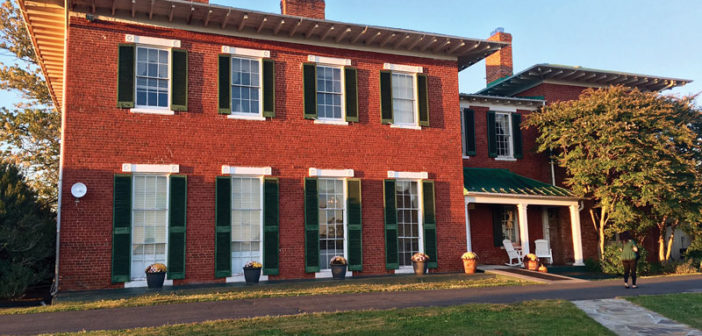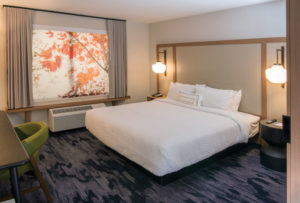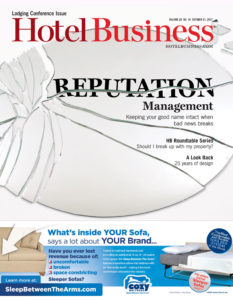HUME, VA—Home is where the heart is, but it’s also where inspiration—much like family—is found and nurtured. Here, at the Marriott family’s country retreat, affectionately called Fairfield Farm, the Fairfield by Marriott brand was born. And Hotel Business was invited by Marriott to see where it all began—to see where the Fairfield by Marriott brand’s inspiration started.
The verdant landscape of rolling foothills and shady old trees in Virginia’s Blue Ridge mountains was enticing to founder J. Willard Marriott Sr. as it reminded him of his childhood in Utah. In 1951, he purchased the property and, over time, continued to buy more land, accumulating some 4,200 acres. It served as a respite from the busy life of a hotelier.
Today, the brand marks a significant milestone—its 30th anniversary. The Inn at Fairfield Farm at the Marriott Ranch is now a bed and breakfast—the only one of its kind in the hotel giant’s portfolio—and mainly hosts small corporate retreats, weddings and other large groups, offering a three-course breakfast and Wild West-style activities.
Sitting at a farm table with a handful of by-invitation-only attendees—journalists, social media influencers—and Marriott executives, it was elbow meets elbow and there was lively chatter over down-home cooking, as well as a genuine sense of togetherness.
It’s like you’re family when you’re at the farm, and that is exactly what the team at Marriott wanted to portray in the launch of its newest interior design prototype, which encompasses all areas including the lobby, dining area and guestrooms. It not only commemorates the 30-year legacy of Fairfield by Marriott, but also pushes forward the notion of chic, farmhouse style for the modern, everyday traveler.
Simple, warm and peaceful with a subtle nod to its country roots, the design evokes the farm through rugged elements like wood and stone. There are also softer textures, some inspired by the animals here, in the form of horsehair-style pillows; a neutral color palette punctuated with an earthy rust red and grass green pulled from the landscape; and carpets with organic-shaped patterns to mimic the blue sky seen from any vantage point on the farm. And, a hearth helps to underscore that feeling of warmth and hospitality, serving as a gathering spot for friends and family alike.
Debbie Huguely, VP of design for select-service/extended-stay, Marriott International, served as the design principal. To draw inspiration, Huguely and her team descended on the family ranch a couple of years ago to take in the picturesque landscape, roaming cattle, mud-splattered Jeeps and the interiors of the Marriott family’s 200-year-old manor house.
“We started the design work at the end of 2015. Not only did we spend some time here, we did some trend spotting. What is so great is that we have such a strong heritage for this brand. We said, ‘Let’s tell a story about it,’ and so that’s what we’ve done,” said Huguely. “We also know our guest. This guest is a busy traveler and they’ve got a lot of productivity they need to focus on. So, what type of homey environment can we create? One of the things that the Marriott family always says about the farm is ‘It was our vacation house.’ When you think about that, it was a place to get away and de-stress, too. We asked ourselves, ‘Who are our consumers and what are they looking for?’ Having the heritage of the farm was perfect.”
To underscore a feeling of hospitality, the design team opted to have the front desk tilted toward the front door, serving as the first greeting to the guest and providing a visual connection.
“When we talk about trusted service, this is one of the things we do. Also, the associate can come around the front desk and greet the guest as well. We try to break down that barrier,” Huguely said.
For this project, the design team eschewed traditional hotel art for moments in nature illustrated through photography that was blown up on wood-backed panels that will appear in the public spaces and guestrooms of every Fairfield hotel.
“I am most proud of the photography, how we put it together and presented it in a unique way. That is photography that is truly ours; it’s from our heritage. It presents such a calming, beautiful and peaceful environment,” she said. “A lot of people talk about hotel art and, in this case, it’s about how the art relates to us. This art, to me, really speaks to the brand and has a story.”
Marriott’s Callette Nielsen, VP and global brand manager, also was deeply involved in bringing the project to fruition and noted that the use of color throughout—tones drawn from the family farm—helps to drive home that feeling of warmth. Another aspect of home—one of her favorites—is the family table, which is in the dining area off of the lobby.
“One of the features that we experienced at the farm was the breakfast. We pulled in some key features—the dining area and also another interpretation of the farm table,” said Nielsen.
“As you drive to the farm, there’s this beautiful red barn with the Marriott logo on it. We have a picture that we captured of the barn itself at sunrise. We wanted guests to see that as they enter the dining area,” said Huguely. “With the farm table, there is the same language as in the lobby to really set it off. It’s a place people can gather throughout the day, whether it’s for breakfast or a casual moment in the evening. It’s a nod to Fairfield Farm.”
It’s all about the details and the importance placed on making the design prototype cohesive. Other elements include modernized spindle chairs with a woven texture, floors with a wood plank design, classic subway tile for the kitchen’s backsplash and a return to the farm’s natural color palette.
While a farm may be a place to get away from it all, Fairfield’s new design also recognizes the traveler’s need to stay connected. “It’s a modern world, so there are plugs you can easily find and access to remain productive and charge your phones,” said Nielsen. “All of those things are integrated in, so they’re there and functional, but don’t take away from the beauty of the design.”
Elsewhere, Nielsen noted that the virtues of home were also pulled into the guestrooms.
“In a very compact space, we were able to pull through more moments of serenity, simple relaxation, balance and an escape from hectic lives into a stress-free environment,” said Nielsen. “The lighting is all inspired by some of the things you’d see at the farm, but a modern interpretation of them.”
For Huguely and her team, there was careful consideration about how to bring elements of warmth and simplicity into the places where guests lay their heads after a long day.
“There’s simplicity in the ease of being able to navigate the room. It’s uncluttered and exactly what the guest needs and not much more,” said Huguely. “One of the great things is this piece of artwork that we have turned into a window treatment. It is photography taken from the farm and the sheer treatment is this natural, organic design that the guest will see upon their arrival.”
Huguely added, “We also talked about how we can transition from work to lounge with the chair in the room. It’s a comfortable chair and has a smooth and natural form to it. The headboard’s texture has some graining of the wood and there’s a linen type of look to pieces within the guestroom. We layered different textures to add visual interest. It has a look that is collected over time.”
After 30 years, how fitting it is for the brand to return to its birthplace to recall the past in order to meld it with the future. The design will roll out property-wide in the coming months, with Boston among the first cities to receive the new treatment. HB




